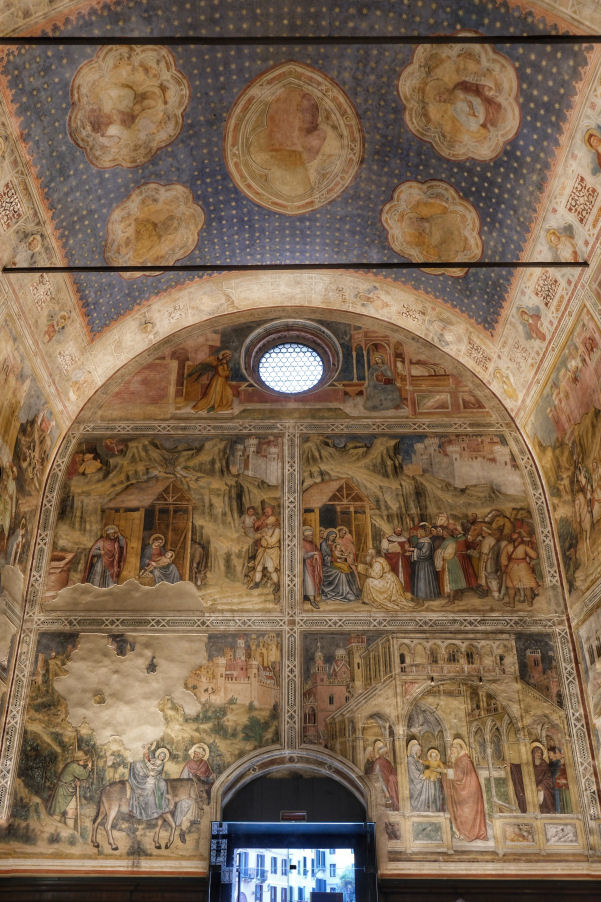History
Built by Franciscans to house the tomb of Saint Anthony of
Padua, the order's second
saint after their founder, this church became their second most
important after the founder's church at Assisi. Anthony, born in Lisbon
and baptised Ferdinand, was canonised by
Pope Gregory IX on 30th May 1232, a year after his death and construction
here began later the same year. When he had fallen ill in Camposampiero,
outside Padua, he had asked to be brought to Santa Maria Mater Domini to
die. Dying on the way back, he had duly been brought to and buried in this small church
which probably dated from the late 12th century. This church was incorporated into the present basilica as the
Cappella della Madonna Mora (Chapel of the Dark Madonna). Work on the
basilica was completed around 1350, and his body was transferred to the
presbytery here on
8th April 1263, moving to its present location in 1310. There were many modifications
to the church, from the rebuilding needed following the collapse of a
campanile struck by lightening in April or May 1394 to the 1449
construction of the twin campanili, which left the church looking much as
we see it today, with repairs following
fires in 1567 and on the 29th of March1749, the latter destroying a large
part of the roof and several paintings. What is described as 'an
unfortunate campaign of redecoration' was undertaken in 1894.

Exterior
Brick with mostly gothic detailing, using white marble. The cluster of
five cupolas is striking, with the central one being conical, with two
towers behind and two minarets. In plan the five domes form a cross. The facade has four deeply recessed arches
with the door in the middle topped by a 1940 copy by Nicola Lochoff of Mantegna's lunette
fresco of 1452 of The Monogram of Christ with Saints Anthony and
Bernardino. The original is now in the museum here (see above). Above the lunette is a
1940 copy by Napoleone Martinuzzi of a statue of Saint Anthony, the original by Rinaldino of
France is in the museum here too. Above is a loggia of 17 columns topped
by a pediment with a rose window flanked by two mullioned windows.
Interior
More unmixed gothic in style than the exterior. A looming wide
nave is separated from its aisles by chunky square brick columns clustered
around with 16th century memorials of nobles and a few fresco panels of the
Virgin and Child.
The first two pillars even have altars on them, facing the entrance. The
one on the left has the soppy Madonna del Pilaster, a
mid-14th-century fresco by Stefano da Ferrara (the saints and angels are
later additions. Another side of this column has a fresco of Saint Anthony
in the Walnut Tree by Pietro Annigoni. The ceiling is a sequence
of domes.
The jazzy third chapel on the right is Chapel of the Holy Sacrament
(Cappella del Santissimo Sacramento, also known as Cappella Gattamelata),
sometimes reserved for prayer. It houses the tomb of Gattamelata, whose
famous equestrian statue is outside, and of his son Giannantonio. The
bronze tabernacle here is by Girolamo Campagna. The arched niche behind
contains a mosaic representing The Holy Spirit with rays of light
descending, made by Lodovico Pogliaghi between 1927–36.
The forth bay on the left has the tomb of Antonio Roselli by Pietro
Lombardo made between 1464 and 1467 and said to have been inspired by the
tomb of Leonardo Bruni by Bernardo Rossellino in Santa Croce in Florence.
For the now-enclosed choir (not freely accessible) (see photo below
right) Donatello
made the Santo Altarpiece from 1446-9,
after he was brought to Padua to make the Gattamelatta equestrian statue,
staying for ten years.
It is topped by a bronze Crucifix, which was originally over the
doorway in the choir screen, along with the statues of the
Virgin and Child and six saints: Anthony, Francis, Prosdocimo,
Giustina, Louis and Daniel. There are also twenty-one bronze reliefs,
consisting of twelve musical angels, the four Evangelists’ symbols (all
quite small) and four larger partly-gilded bronze reliefs of The Miracles of Saint
Anthony (The Ass of Rimini (see below), The Speaking Child, The Irascible Son
and The Miser’s Heart) and a Dead Christ Supported by Angels.
Behind is the polychromed limestone relief The Entombment of Christ,
which has lead a fraught life, including use as a lintel and gilding
in the 18th century, but is soon to undergo restoration. This high altar
was dismembered in 1579, and speculatively rebuilt in 1895 by Camillo
Boito, there have been many theories (around sixteen so far) and arguments
since, as no record remains of its original arrangement, excepting a
partial description by Venetian Marcantonio Michiel from 1520.
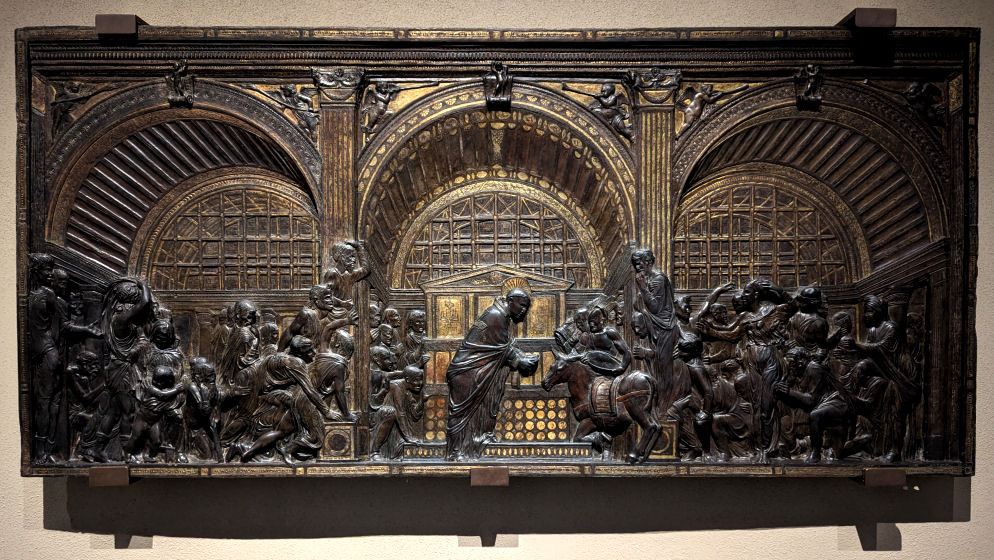
The cast court of the Victoria and Albert
Museum in London has many casts of the Santo's Donatello Altarpiece, so
it's easier to see them there than here. These include twelve angel panels,
a panel of The Dead Christ , four panels of The Miracles of
Saint Anthony and a figure of Saint Francis.
The transept is formed of two large chapels:
On the right is the large Chapel of San
Giacomo (or San Felice)
(see below right). Opposite is what might be described as
the spiritual heart of the basilica -
St Anthony's Chapel (see less
below right).
Through an arch to the right of Saint
Anthony's chapel is the
Cappella della Madonna Mora, all that
remains of the earlier church of Santa Maria Mater Domini. It is so named
because the statue above the altar is of the Virgin with dark hair. It is the
work of by Rinaldino di Puy-l'Evéque and dates from 1396. Rinaldino
also being responsible for the Saint
Anthony over the Santo's door. Behind the statue is a fresco depicting
The Glorification of the Virgin between prophets and angels
previously thought to be by a
'disciple' of Altichiero but identified in 2015 as by Giotto. Frescoes here
also include a very damaged Jesus Leaving his
Mother by Giusto de Menabuoi.
Off of this chapel to the left is the highlight
Capella dei Santi Filippo e Giacomo e del Beato Luca Belludi
(see photo right) the last named being Saint Anthony's companion,
whose name was added to the chapel's dedication after his beatification in
1910. He is buried here, although his body is believed to have been put in
Anthony's original bier, with frescoes of around 1382 by Giusto de' Menabuoi and
his studio. The work was commissioned by brothers Manfredo and Naimerio
Conti, after whom the chapel is also sometimes named. The frescoes depict scenes from the lives of Saints Philip, James the
Younger and the Elder and of Luke Belludi and were restored in 1988. The most
famous panel is probably on the left wall of the apse, where Saint Anthony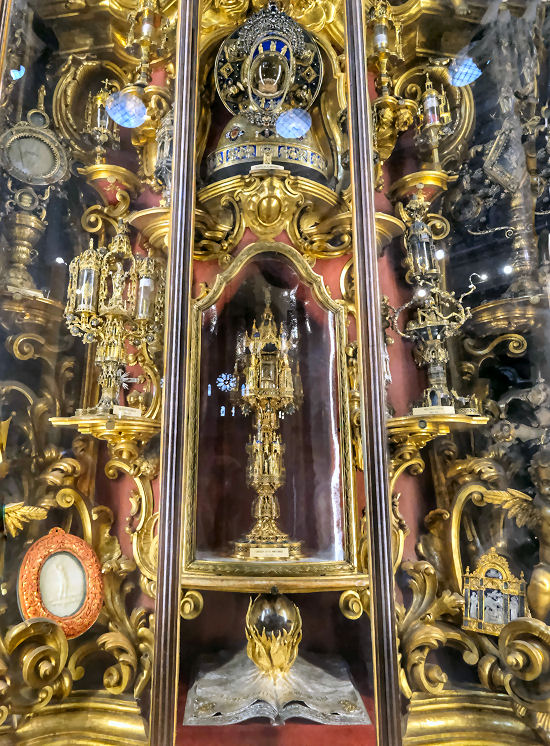 appears to the
Blessed Luke,
with it's impressive panorama of Padua, although all the scenes here
have impressive architecture. The weird toppling tower scene on the right
depicts a merchant miraculously freed from a tower by Saint James the
Great. appears to the
Blessed Luke,
with it's impressive panorama of Padua, although all the scenes here
have impressive architecture. The weird toppling tower scene on the right
depicts a merchant miraculously freed from a tower by Saint James the
Great.
The Chapels in the Ambulatory are all frescoed,
mostly in the early 20th century, the third and fourth on the left and second and
third on the right in imitation gothic style. Through an
arch in the centre of the ambulatory is the 17th century
Reliquary Chapel,
designed by Filippo Parodi, a pupil of Bernini, on the site of a chapel
dedicated to Saint Francis. It has the
Saint Anthony chin reliquary as well as the better-known tongue one (in
the centre of the photo right). A
finger and some hair is to be found here too, along with a habit,
parchments and coffins. It is
not for the faint-hearted or the baroque-averse.
The first chapel on the right
in the ambulatory, the Cappella di Santa Caterina, just
past the entrance to the sacristy, has three paintings by Pietro Annigoni
inside, and frescoes in the underside of the arch of eight saints
attributed to Giotto, or at least his workshop. They have been much
repainted, especially the faces. This chapel probably originally belonged
to the Scrovegni family - their coat of arms, a blue sow on an ochre
background, is still visible painted on the entrance arch - possibly a
commission by Enrico Scrovegni from before the Arena
Chapel commission.
The chapter house, beyond
the sacristy through the door to the right of this last chapel, has
fragmentary frescoes also attributed to Giotto, at least partially, found
under plaster and whitewash in the mid-19th and early-20th centuries. They
depict Saints and Prophets in fictive niches, part of a
Crucifixion and a Stigmatization of Saint Francis. It is
thought that, having been brought here by the Franciscans after his work
at Assisi, it was whilst working here that he met Enrico Scrovegni, which
led to his commission to decorate Scrovegni's
Arena Chapel.
To the right of the sacristy door is the short passageway between the church and the
Cloister of the Magnolias. It has, on the left, the tomb of Federico
Lavellongo, with sculpture by Giovanni de Santi and a fresco in the
lunette of The Virgin and Saints Worshipped by Lavallongo
attributed to Altichiero. Opposite is a tomb with a fresco of the
Coronation of the Virgin by Giusto de'Menabuoi (see photo below).
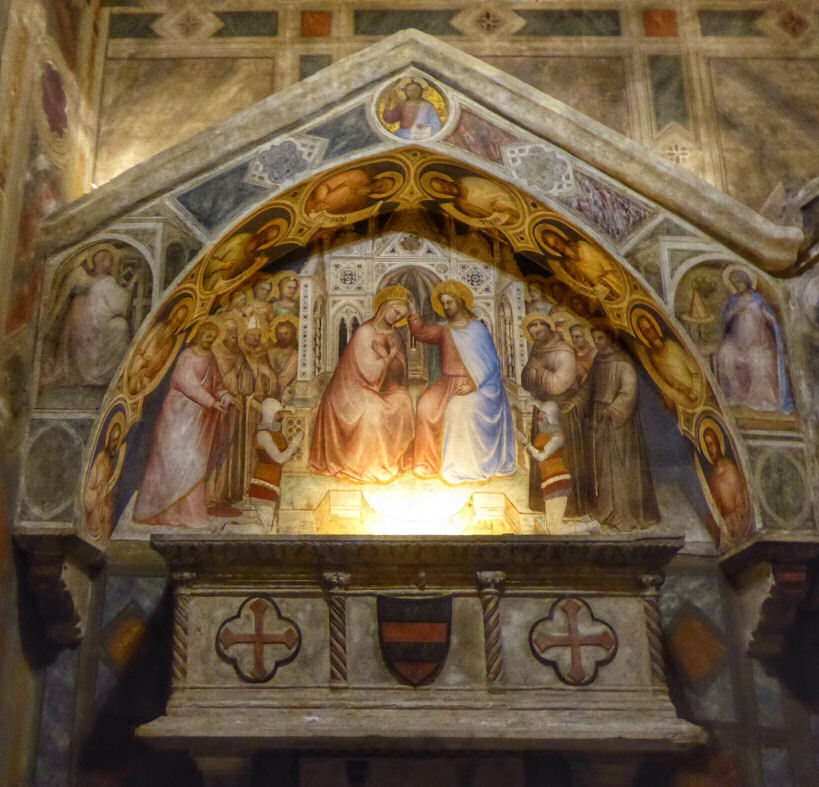
Lost art
A panel from a predella depicting The Descent of Christ into
Limbo by Jacopo Bellini is, it has been suggested, from the predella
of an altarpiece that was in the Gattamelata Chapel here, signed by Jacopo
along with his sons Gentile and Giovanni in 1459 or 1460. It is now in the Eremitani Civic Museum. There are other
predella panels in Ferrara (an Adoration of
the Magi possibly by Giovanni, based on designs by Jacopo) and the Correr in Venice (a Crucifixion).
A left-hand main-register panel of
Saints Anthony Abbot and Bernardino in Washington may be from
the same altarpiece.
The walls of Saint Anthony's Chapel were once covered
in a cycle of frescoes, attributed to Stefano da Ferrara, showing scenes
from the saint's life and his miracles. It is lost.
The Anthonian Museum
In the cloister of the Blessed Luca Belludi, named for Saint
Anthony's companion. Contents include the lunette fresco by Mantegna for the Basilica’s doorway
and seven 18th century altarpieces, mostly martyrdoms, by Giacomo Ceruti,
Giambattista Tiepolo (The Martyrdom of Saint Agatha, 1735/6), Antonio Ballestra, Giambattista Pittoni,
Pietro Antonio Rotari, Giovanni Antonio Pellegrini, and Giambattista
Piazzetta, commissioned for the ambulatory chapels.
It begins with a
bewildering maze of glass cases containing votive plaques and offerings
and too much weird stuff for a non-believer to comprehend. This is
followed by a permanent exhibition called ‘Donatello in the Basilica’
established in 2015. It has photos, plaster casts and information panels
about the works Donatello made for the Santo, but which they won't let you
get close enough to see properly in the church.
But it's in the un-signposted-to
upstairs gallery that the best stuff is displayed. There are sweet fresco
fragments, including the lunette and altarpieces just mentioned. Also a
Carpaccio Virgin and Saints altarpiece on long-time loan. Painted
for the convent of San Francesco di Pirano, it was looted by the Nazis and
eventually returned here. The Santo website says that the original altar
that it was taken from has been readied for its return since at least
2000. A Titian sinopia from the scuola next door is so faint as to defy
comprehension. There are robes and ecclesiastical silver up here too.
Opening times
Basilica
Weekdays 6.20am - 6.45pm
Easter to end of October 6.20am - 7.45pm
Saturdays and Sundays 6.20am - 7.45pm
Museum
Tuesday to Friday 9.00-1.00
Saturday and Sunday 9.00-1.00, 2.00-6.00
Oratorio and Scuola (see below)
April - September 9.00-12.30, 2.30-7.00
October-March 9.00-12.30, 2.30-5.00
€3.00 each or €6 for both
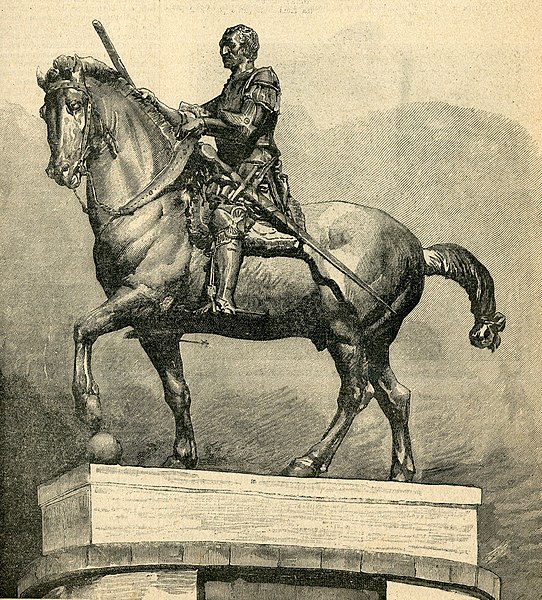
The Courtyard
in front of the church, which was once used as a
cemetery, has Donatello's famous bronze equestrian statue of
1447-50 (see right) of Erasmo da
Narni, known as Gattamelata (the honeyed cat, sometimes interpreted
as calico cat or speckled cat) the Venetian condottiere who
became Podestà in Padua in 1437. He had lead Venice's conquest of Padua. The nickname is said to derive from his
mother's name, she being called Melania Gattelli). The statue was commissioned by
his wife, Giacoma da Leonessa,
and is famed as
the first equestrian statue cast in bronze in Italy since antiquity. The
tall plinth, also the work of Donatello, has two doors, one open and one ajar,
symbolic of the doors to the underworld. Above are two reliefs, on one
there are two putti pointing to the coat of arms of the deceased, on the
other two angels with armour. The badly weathered originals are now in the
Santo Museum, having been replaced with copies in the 19th century.
Update September 2023 The statue is covered in scaffolding.
Update November 2024 Restoration work has reportedly began.
Along the south side of
this courtyard are...
|
|

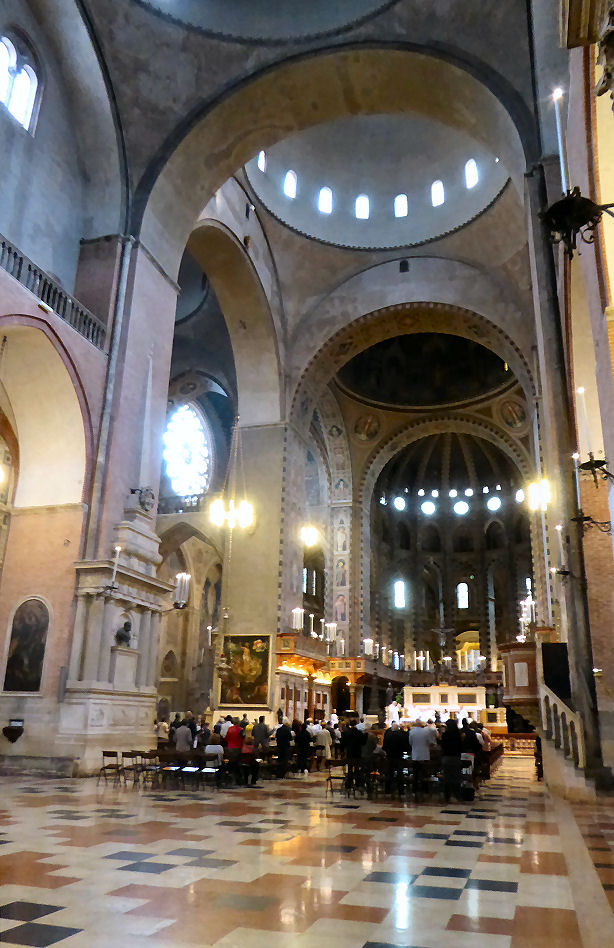


St Anthony's
Chapel
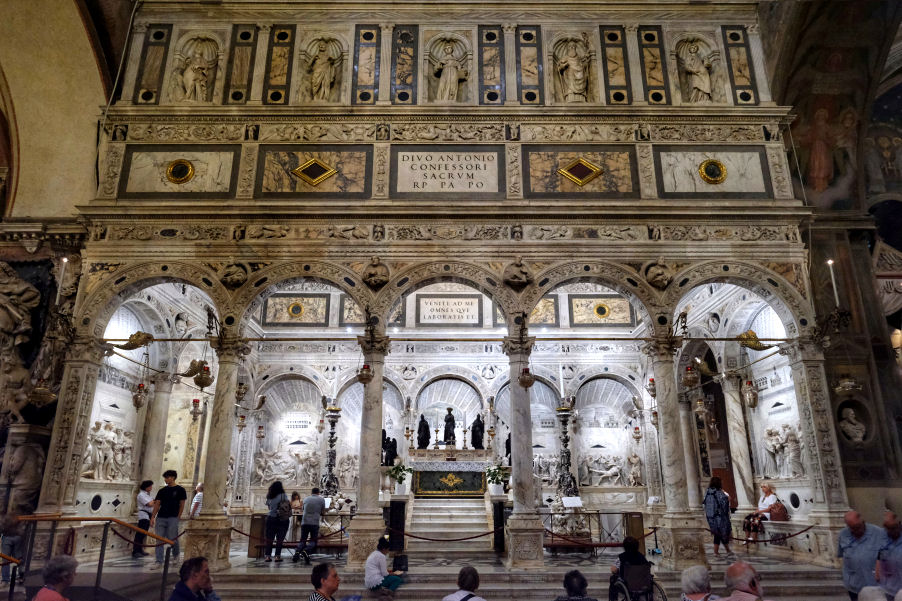
The saint's body was moved often, from it's original resting place in
Santa Maria Mater Domini, which became the Cappella della Madonna Mora
here,
then during the various stages of rebuilding was moved to the high altar, possibly,
and to a marble sarcophagus on columns, and finally to this chapel in the
north transept in 1350.
It is not known why it was decided to make the
tomb accessible to all, and not buried in a crypt visitable only by a
select few, as at Assisi. On April 8th
1263 the tomb was opened in the presence of Saint Bonaventura. His body
had decomposed but Anthony's tongue was found to be intact, 'rubicond and beautiful', and so the
miraculously preserved organ was removed and placed in a reliquary still
kept in the reliquary chapel here.
The original gothic chapel was completely rebuilt in renaissance style in
the 16th century This chapel's screen
of red marble columns is now to be found supporting the portico of the church
of
Santa Maria dei Servi. The previous structure is said to have
been similar to the chapel of San Giacomo opposite, with a five-bay arcade
with statues in niches above. It had a now-lost fresco cycle attributed to
Stefano da Ferrara depicting, amongst other things, four miracles and the
death of St Anthony. There are now bas-reliefs of the life of the saint by
Antonio Minello, Jacopo Sansovino (Resurrection of a Drowned Girl
and Saint Anthony Resuscitates a Drowned Boy), Tulio Lombardo (The
Miracle of the Usurer and Saint Anthony Reattaches the Foot of a
Young Man.) These four are the 4th to 7th of the panels. The 9th is
Saint Anthony Makes the Newborn Baby Speak in Order to Attest his Mother's
Honesty by Antonio Lombardo, the brother of Tulio.
The
Chapel of San Giacomo
Bonifacio Lupi, a condottieri, relative of the Carrara and a guelf exile from Parma, had hoped to
be buried in the baptistery in Florence. When this request was refused he
commissioned this chapel to be built. But documents recently discovered
show that it was initially planned as a resting place for his
grandfather, Guglielmino Rossi, and his uncles Rolando, Pietro and
Marsilio. The sarcophagus on the left contains their remains. Andriolo di
Santi was employed to construct a chapel imitating the then-gothic
appearance of Saint Anthony's chapel opposite. Work began in February 1372,
and went on until December 1375 when, following Andriolo's death, the work was
completed by his son. Altichiero worked on the frescoes from 1377-1379.
Bonifacio himself had initiated the commission in 1372 but his wife
Caterina supervised from October 1374 to July 1375. Her portrait is said
to appear several times in the frescoes, but some controversy surrounds
this assertion.
The lower register of the back wall is
dedicated to the Life of Christ, with the Crucifixion in the
centre (see above), the Annunciation in spandrels in the far
corners, and the
Entombment and Resurrection in lunettes above the two
flanking tombs. Saints with Franciscan and Paduan connections are depicted
in eight medallions in spandrels on the back wall and on the inner façade.
Doubts as to how much of the work here and in the Oratorio di San Giorgio
was actually done by Altichiero himself have been expressed. That these
works were made in collaboration with fellow Veronese Jacopo D’Avanzi is
mostly accepted, but the division between them is constantly argued. The
most recent scholarship gives them to Altichiero solely, but with a
different hand detected, especially in five of the eight lunettes.
Scenes from the life of St James of Compostella take up the rest of
chapel, beginning in the upper lunettes on the east wall and wrapping
around the west and south walls to end beneath their starting point on the
lower tier. The choice of scenes is a little eccentric, with the family
thought to be responsible for choosing episodes from the saint's life
involving his persecution by the wicked Queen Lupa, who later converted
and had her palace converted into a church. The similarity between her
name and theirs is thus celebrated, along with her and they having
endowing foundations dedicated to St James. Portraits of family members,
their allies, such as the ruling Carrara family, and friends like Petrarch
and Lombardo della Seta, his secretary, appear in some scenes too. There
are also many representation of wolves (lupi) to be found around -
on the façade, the tomb, the ceiling, the two lecterns and on the
celebrant's vestments.
An altar here, dating to 1503, contained relics of
Saint Felix, giving the chapel its changed name in the early 16th century,
until it was demolished in 1966.
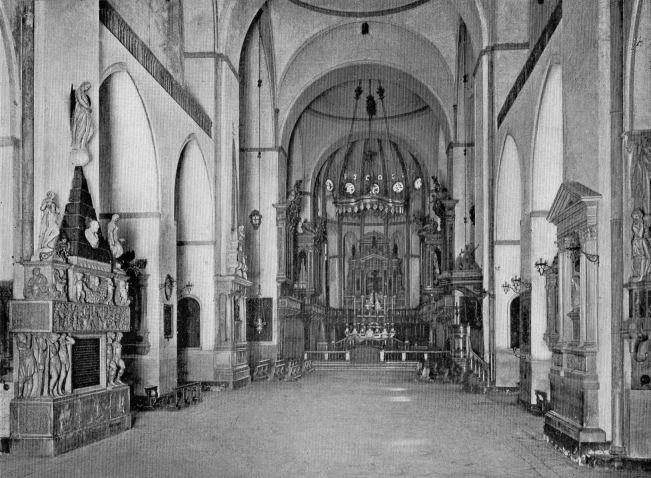
A photograph showing the Baroque altar of 1651-8 by Mattia
Carneris, before it was
replaced by the reconstruction of Donatello's altarpiece in 1895 by
Camillo Boito.
|

